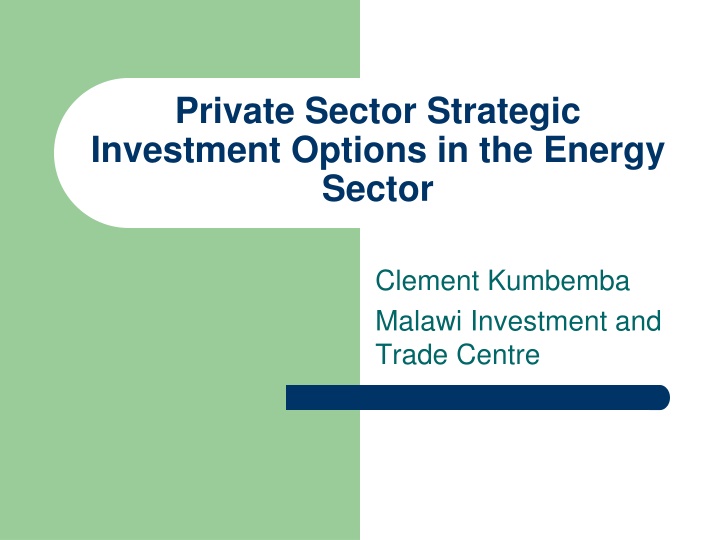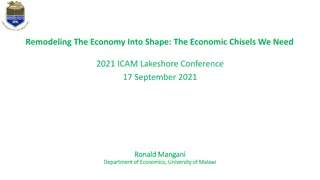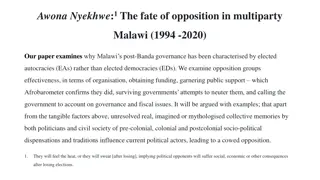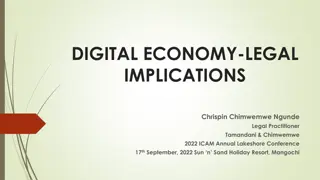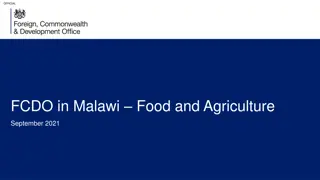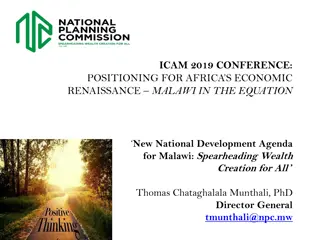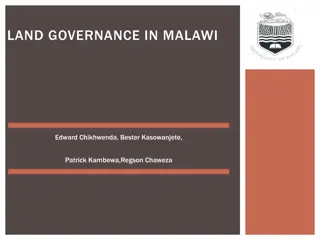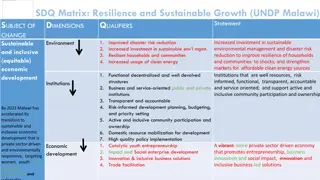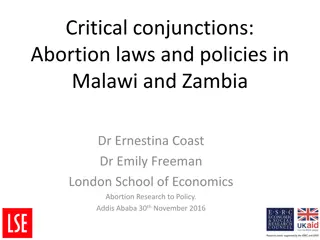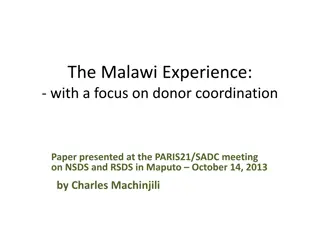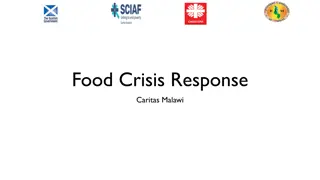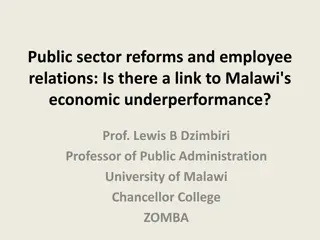Strategic Energy Investment Options in Malawi
The energy sector in Malawi presents investment opportunities but faces challenges hindering its full potential. With hydro-electricity as the main energy source, the sector requires improvements in generation and transmission capacities to meet growing demand.
Download Presentation

Please find below an Image/Link to download the presentation.
The content on the website is provided AS IS for your information and personal use only. It may not be sold, licensed, or shared on other websites without obtaining consent from the author.If you encounter any issues during the download, it is possible that the publisher has removed the file from their server.
You are allowed to download the files provided on this website for personal or commercial use, subject to the condition that they are used lawfully. All files are the property of their respective owners.
The content on the website is provided AS IS for your information and personal use only. It may not be sold, licensed, or shared on other websites without obtaining consent from the author.
E N D
Presentation Transcript
Private Sector Strategic Investment Options in the Energy Sector Clement Kumbemba Malawi Investment and Trade Centre
Outline Sectoral Contribution The Energy Sector Environment for Private Sector Participation Options for Private Sector Investment The Challenges
SECTORAL CONTRIBUTION IN GDP SECTORAL CONTRIBUTION TO GDP (IN PERCENTAGES) Sector Agriculture, forestry and fishing Mining and quarrying Manufacturing Electricity, gas and water supply Construction Wholesale and retail trade Transportation and storage Accommodation and food services Information and communication Financial and insurance services Real estate activities Professional and support services Public administration and defense Education Health and social work activities Other Services 2013 29.9 2014 29.9 0.9 9.5 1.3 2.8 15.8 2.7 1.9 4.1 2015 28.6 0.9 9.6 1.3 2.8 16 2.7 1.9 4.3 5.2 7.7 0.3 2016 28.1 0.9 9.4 1.2 2.7 16.1 2.7 2017 28 0.8 9.3 1.2 2.6 16.2 2.7 1 9.5 1.3 2.8 15.8 2.7 1.9 3.9 2 2 4.4 5.1 7.6 0.3 4.3 5.1 7.3 0.3 5 8 5 7.8 0.3 1.9 2.5 2.6 4.8 0.3 2 2 2 2 2.6 2.7 4.8 2.6 2.6 4.9 2.6 2.7 2.6 2.7 4.8 5 Source: National Statistical Office (NSO) and Department of Economic Planning and Development (DEPD)
Energy Sector In Malawi Energy is a crucial input into industrial processing and serves as the life-blood for any economy. Malawi is relatively well endowed with a wide variety of energy resources but a full potential of the energy sub-sector remains far from being realized owing to a number of structural, operational and institutional challenges. Currently the provision of energy in Malawi is inadequate, unreliable and inaccessible to all who need it, account of lack of competition in the sector, non-functioning power plants and inability to generate sufficient amounts of energy. largely on
Energy Sector In Malawi Hydro-electricity is the main source of energy for industry and domestic power requirements in Malawi Until recently there were challenges in both generation and transmission capacity in Malawi. The growth of the industrial sector in constrained by power supply capacity. While infrastructure has been improved courtesy of the Millennium Challenge Account intervention, the generation capacity remains a challenge. Installed capacity was at 351 Megawatts as at 2017 while the generation capacity by Electricity Generation Company between 230MW and 250MW of which 71MW is produced from diesel-powered generators. the transmission and distribution Malawi is Demand growing at 4 per cent per annum . Maximum demand projected at 4,620MW by 2040 for energy is (Egenco) oscillates
Energy Sector Evolution 90% of the population is not connected to electricity signalling a huge demand Before Compact Partnership (2013) 351 MW 450 MW After 2013 Installed Capacity Transmission Capacity 540 MW (End of 2019) 2,000 MW Other developments since 2013 i. Legislation was reviewed to allow IPP actors ii. ESCOM was unbundled into ESCOM and EGENCO iii. IPP framework has been developed iv. 3 IPPs are on the ground v. Kamwamba project with planned capacity of 300 MW to commence construction in 2019 vi. Power Purchase Agreement Framework in place
Policy and Strategy The objective of the MGDS in the energy sector is to reduce the number and duration of blackouts, increase access to reliable, affordable electricity in rural areas and other targeted areas, improve coordination and the balance between the needs for energy and those of other high growth sectors such as tourism and mining.
Environment for Private Sector Participation in Malawi Energy Integrated Resource Plan (2017-2037)- is the blue print for energy sector Independent Power Producers Agreement was launched in 2016 to enable private sector participation in power generation Public Private Sector Partnerships Malawi Energy Regulatory Authority The Millennium Challenge Account- MCC Compact (infrastructure development, power sector reform, environmental management)
Options for Private Sector investment Generation Mode Hydro- electricity Solar Power Tedzani IV (18 Mw) Njoka* (Salima) 60Mw Fufu (100Mw) Kholombidzo (210 Mw) Mpatamanga (309 MW) Golomoti(Dedz a) 20MW* Thermal Power Kam mwamba (300Mw) Liwonde Geothermal Nkhotakota Wind Chitipa Lilongwe Dedza Zomba Bagasse Nchalo Dwangwa
Energy Related Investments Opportunities From challenge To Opportunity In view of climate change, sedimentation, and management of power supply challenges these are possible business areas that the private sector can consider:- Afforestation and plantation opportunities in catchment areas Debt collection ESCOM billing Outsourced procurement
The Malawi Investment Forum (MIFs) MIFs are prime investment promotion events . The role of MITC is to market investment opportunities MIFs were held in 2015, 2016 and 2018 and the events attracted investors in the energy sector
The Malawi Investment Forum (MIFs)- Results Energy Related The energy sectors always attract attention at MIFs MIF 2015 (investment leads worth $1.1 billion recorded; Atlas EnergyUS$80 million to develop a 40 megawatts solar project; MIF 2016 - Lweya Hydro Power Plant in Nkhata-Bay by Water Wheels 20MW MIF 2018 - Voltalia $50,000,000; Rukuru Power Company energy Malawi $7,500,000; Pacific Electric company Production of electrical support facilities $8,500,000 Solar energy Hydro- China
Challenges Prior to 2016, the IPPAs were not clear and lacked transparency (in 2016, twenty-seven IPPs signed a Understanding with government and were awaiting PPAs with ESCOM to roll out their projects). Limited financing for feasibility studies Memorandum of
The Role of Stakeholders The Private Sector can play a lead role in the supply of power Government Prepare feasibility studies for energy projects Offer incentives to investors Private Sector Prepare feasibility studies Mobilize financing consortiums, joint-ventures
Current Incentives for Energy Sector Investments Design deficiencies and pervasive constraints on monitoring and enforcement impede the effectiveness of economic instruments The Energy sector enjoys general and specific incentives General Customs & Excise Tax Incentives Malawi s General Customs & Excise Tax Incentives are in the form of duty exemptions on machinery targeting different sectors of the economy. These exemptions are offered in four (4) exemption approaches
General Customs & Excise Tax Incentives 1. Import duty and import VAT exemption on importation of most Machinery. 2. Import duty exemption while VAT remains payable at 16.5% on importation of specific type of Machinery. 3. Import duty and import VAT exemption on importation of special purpose motor vehicles other than those principally designed for transport of persons or goods. Examples of special purpose vehicles are concrete mixer lorry, mobile drilling vehicles, etc. 4. Solar products are import duty free while VAT remains payable at 16.5%. Examples of such solar products include solar batteries and solar energy lamps. Note
Incentives- Electricity Generation and Distribution Sector Duty free importation but VAT payable at 16.5% on Electricity Generation equipment such as fuses, transformers, sling, ring main unit, insulators, galle chain equipment, conductors, surge arrestors, column duplex, AAC/PVC and electricity supply meters. Duty free importation but VAT payable at 16.5% on energy saver bulbs, solar batteries, solar battery chargers, energy lamps, generators and inverters.
Energy Verdict Government and its agencies alone can not meet national energy requirements Demand for power will always outstrip supply Hydropower - Demand Vs Installed Capacity 800 700 Climate change threatens the reliability of hydro- electricity 600 500 400 300 200 100 0 2007 2008 2009 2010 2011 2012 2013 2014 2015 Installed Hydro Capacity (MW) Maximum (Peak) Demand (MW)
Way forward Private sector should think outside the box case of Nigeria Encourage use of efficient and affordable technology Invest in solar equipment Energy smart premises Define clear policy for off-grid power supply in Malawi- More of Mulanje case study Need for innovative financing in the energy sector
THE END THANK YOU
